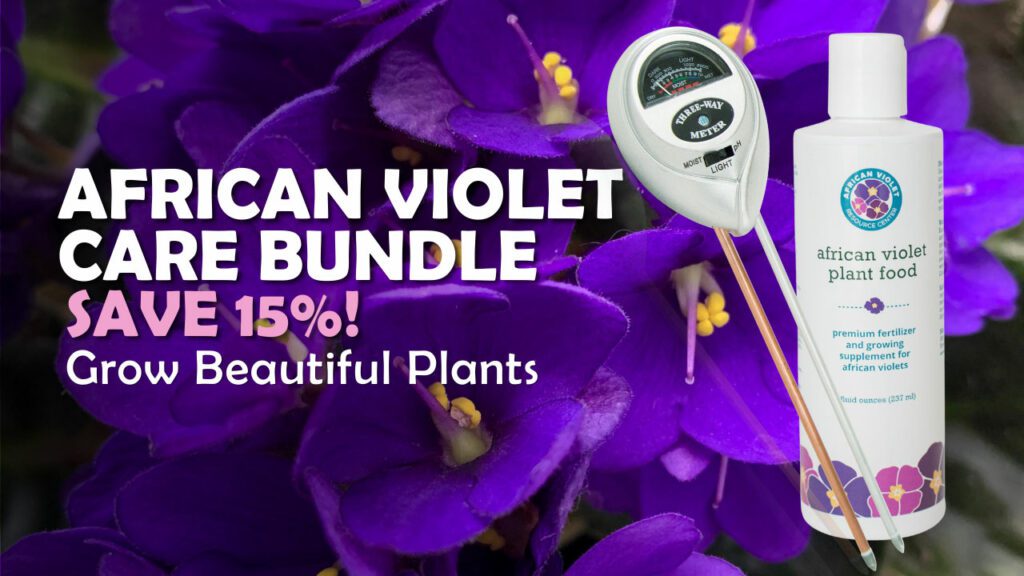Discover the best ways to care for your African violet so it’ll stay alive and thrive year after year.
If you’re here to learn how to keep your African violet alive for years to come, we think it’s safe to assume that gardening is more than just a hobby for you. It’s a practice that fulfills and excites you; it’s something you look forward to every day.
Nurturing your indoor garden gives you joy and pride, and your small but mighty African violet is a plant you cherish. Its year-round colorful blooms and velvety leaves are unique since they help keep your home vibrant even in the winter when your other plants drop their flowers.
We’re excited to bring you some good news. Once you’ve mastered a few basics, your African violet will do more than simply survive. It’ll thrive. And with the right care, your African violet can be a part of your home for more than 50 years.
Below, you’ll find our top 5 tips to keep your African violet alive and thriving so you can watch your hard work pay off for years to come.
Tip #1: Choose a Well-Draining Potting Mix for Your African Violet
Choosing the right potting mix for your African violet is a must. In fact, using any old soil for your plant is a grave mistake. Traditional soils will damage your African violet’s roots and will likely prevent bloom.
The right potting mix for your African violet will be light and porous. This allows your plant’s roots to have access to air and ensures the mix will dry out quickly between waterings.
To encourage your African violet to bloom, keep it in a small pot. African violets bloom only when they’re root-bound; they don’t enjoy big, soil-filled planters.
What the professionals say: We recommend using a potting mix made for African violets in particular. If you’d like to make your own, you can use a mixture of peat moss, perlite, and a small amount of garden soil.
Tip #2: Keep Your African Violet in a Warm Environment
In the wild, African violets grow in the rain forests and mountains of East Africa. They love to take root in the shade of other vegetation in the jungles of Tanzania and the Usambara Mountains. Their natural habitats are warm and humid.
Lucky for us, African violets prefer the same temperatures most people find comfortable. If you keep your home somewhere between 70 and 80 degrees Fahrenheit during the day and between 65 and 70 degrees Fahrenheit at night, your African violet will feel right at home.
Be sure to place your African violet away from floor vents or fans to avoid cold drafts or bursts of cold air.
What the professionals say: To increase the humidity around your African violets, try grouping your plants together. This creates a unique microclimate where plants can thrive off of the collective humidity.
Tip #3: Perfect Your African Violet Watering Routine
African violets need just enough water to keep their potting mix moist. As a general rule, avoid keeping your plant in soggy potting mix, since this can increase the chances of your plant developing root rot.
To perfect your African violet watering routine, follow these 3 simple rules:
- Let your African violet dry out between waterings to prevent root damage.
- Water your African violet from below to avoid getting water on its leaves, which causes leaf damage.
- Use room-temperature water so your African violet’s roots aren’t shocked by cold water.
What the professionals say: If you’re worried about watering your African violet, you can opt for a self-watering pot. These are perfect pots for African violets since they’re designed to keep plants optimally hydrated and they remove the risk of spilling water on your plant’s leaves.
Tip #4: Give Your African Violet Plenty of Indirect Light
African violets need indirect sunlight to thrive. Direct sun will burn your plant’s leaves, while low-light conditions will prevent bloom and cause your plant to wilt and turn yellow.
Your African violet will tell you if its light conditions are less than optimal. Be on the lookout for leggy, elongated leaves and stems which signal that your plant isn’t getting enough indirect sunlight. On the other hand, brown spots or damaged leaf tips are a sign that your plant is sunburnt and getting too much direct light.

What the professionals say: Rotate your African violet each week or watering period. This will prevent uneven growth and ensure your plant receives equal sunlight on all sides.
Tip #5: Use an African Violet Fertilizer Regularly
Like all plants, African violets need nutrients to thrive. In the wild, African violets are privy to a diverse natural microbiome, but indoor conditions are much less diverse. Ultimately, it’s up to you to provide the nutrients for your plant.
After a few months, the nutrients in your African violet’s potting mix will become depleted. You’ll want to use an African violet fertilizer to provide key elements for growth, improve nutrient uptake, and correct soil deficiencies. The right fertilizer will act as a multivitamin for your plant and encourage big, bold blooms and lush, velvety leaves.
What the professionals say: Use a gentle, urea-free liquid fertilizer every time you water. Our African Violet Plant Food is made with humic-fulvic acid and sea kelp extract to boost nutrient uptake and encourage hearty roots and vibrant blooms. It’s gentle enough to use every time you water and won’t burn your plant’s delicate root system.
A Recap: How to Keep Your African Violet Alive
There you have it. Five foolproof ways to keep your African violet alive for years to come.
To recap, here are the secrets to vibrant, long-lasting African violets:
- Choose a porous, well-draining potting mix for your African violet.
- Keep your plant in a warm, temperate environment around 70 degrees Fahrenheit.
- Use a self-watering pot to prevent water from getting on your plant’s leaves and ensure proper hydration.
- Give your plant plenty of indirect sunlight.
- Use a gentle African violet fertilizer to encourage big, hearty leaves and eye-catching blooms.
For continued success, explore our other articles, visit our online shop, and connect with other African violet plant lovers in our Facebook group. There, you’ll find everything you need to know to grow your African violet big and strong so you can enjoy it for a long, long time.







